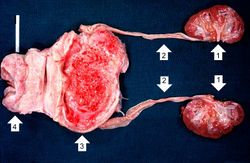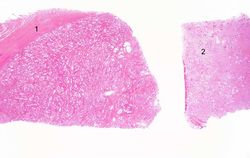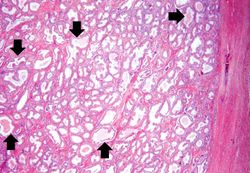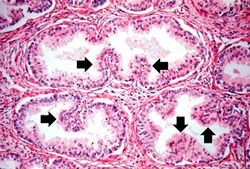IPLab:Lab 2:Hyperplasia
Contents
Clinical Summary[edit]
This 87-year-old man dated the onset of his illness to approximately six months prior to admission at which time he noted difficulty in starting his urine stream. He was seen several times in the emergency room for acute urinary retention and dysuria. On several occasions, significant numbers of white blood cells and bacteria (suggestive of acute cystitis) were noted in the patient's urine specimen.
Terminally, the patient developed fever, confusion that progressed to coma, convulsions, and shock. At the time of his death, the patient's major clinical problem was Gram-negative sepsis secondary to a urinary tract infection.
Autopsy Findings[edit]
At autopsy the prostate gland was grossly enlarged (6.5 x 4.8 x 3.2 cm) and weighed 75 grams. The prostate gland was nodular but the nodules were confined within the prostatic capsule.
Images[edit]
This kidney was removed from another autopsy patient who had prostatic hyperplasia resulting in marked urinary retention and back-flow of urine from the bladder into the ureters and renal pelvis. The increased pressure inside the renal pelvis resulted in dilation of the renal pelvis (1) and pressure atrophy of the cortex (2). This change in the kidney is called hydronephrosis.
Virtual Microscopy[edit]
Prostatic Hyperplasia[edit]
Normal Prostate[edit]
Study Questions[edit]
Additional Resources[edit]
Reference[edit]
Journal Articles[edit]
- Wang TJ, Slawin KM, Rittenhouse HG, Millar LS, Mikolajczyk SD. Benign prostatic hyperplasia-associated prostate-specific antigen (BPSA) shows unique immunoreactivity with anti-PSA monoclonal antibodies. Eur J Biochem 2000 Jul;267(13):4040-5.
Images[edit]
| |||||
"Urinary retention" is the inability to fully empty the bladder during urination.
"Dysuria" is the experience of pain upon urination.
"Cystitis" refers to an infection of the urinary bladder.
Gram-negative sepsis is a systemic inflammatory response caused by the presence of Gram-negative bacteria and their endotoxins in the blood. The microbes usually enter the bloodstream from an area of localized infection. Gram-negative sepsis is the leading cause of septic shock--hence, also known as "endotoxic shock." Septic shock is a syndrome of inflammatory responses which can lead to severe hypotension, multiple organ system failure, and death.
The dimensions of a normal prostate are 3.6 x 2.8 x 1.9 cm. So this prostate is enlarged.
Normally, a prostate in an 80 year old man should weigh about 40 grams.
Nodular hyperplasia of the prostate--characterized by large discrete prostatic nodules--is a common disorder in men over 50 years of age. The nodules cause the prostate to be enlarged and to have an increased weight. The human prostate is surrounded by a restrictive capsule. These nodules cause increased pressure within the capsule which leads to constriction of the urethra as it passes through the prostate. Urethral constriction leads to retention of urine.
Prostate carcinomas spread through the capsule at an early stage, thus these nodules are more likely not to be cancer.
Hydronephrosis is dilation of the renal pelvis and atrophy of the cortex due to increase pressure from retained urine.
The normal fibrinogen level is 184 to 412 mg/dL.








